

New Swallowable Sensor Could Transform Our Understanding of the Human Gut. In Brief New swallowable sensors could illuminate dynamic systems of the gut that were previously hidden.
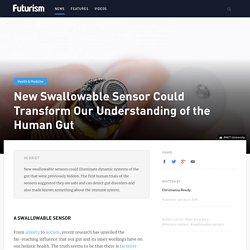
The first human trials of the sensors suggested they are safe and can detect gut disorders and also made known something about the immune system. A Swallowable Sensor From anxiety to autism, recent research has unveiled the far-reaching influence that our gut and its inner workings have on our holistic health. The truth seems to be that there is far more complexity to our digestive tract than we usually recognize. Overview of Nanotechnology. Nanotechnology draws its name from the prefix "nano".
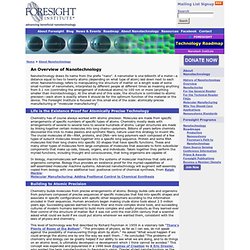
How Nanotechnology Works" There's an unprecedented multidisciplinary convergence of scientists dedicated to the study of a world so small, we can't see it -- even with a light microscope. That world is the field of nanotechnology, the realm of atoms and nanostructures. Nanotechnology is so new, no one is really sure what will come of it. Even so, predictions range from the ability to reproduce things like diamonds and food to the world being devoured by self-replicating nanorobots.
YouTube Intro to Nano Technology. Nano. Michio Kaku: Can Nanotechnology Create Utopia? Nanotechnology News - Nanoscience, Nanotechnolgy, Nanotech News. The Foresight Institute. Nanotechnology and Nanoscience. Nanotechweb. Carbon nanotubes in photovoltaics. Organic photovoltaic devices (OPVs) are fabricated from thin films of organic semiconductors, such as polymers and small-molecule compounds, and are typically on the order of 100 nm thick.
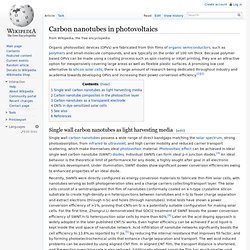
Because polymer based OPVs can be made using a coating process such as spin coating or inkjet printing, they are an attractive option for inexpensively covering large areas as well as flexible plastic surfaces. A promising low cost alternative to silicon solar cells, there is a large amount of research being dedicated throughout industry and academia towards developing OPVs and increasing their power conversion efficiency.[1][2] Single wall carbon nanotubes as light harvesting media[edit] Single wall carbon nanotubes possess a wide range of direct bandgaps matching the solar spectrum, strong photoabsorption, from infrared to ultraviolet, and high carrier mobility and reduced carrier transport scattering, which make themselves ideal photovoltaic material.
CNTs in dye-sensitized solar cells[edit] Optical properties of carbon nanotubes. Within materials science, the optical properties of carbon nanotubes refer specifically to the absorption, photoluminescence (fluorescence), and Raman spectroscopy of carbon nanotubes.
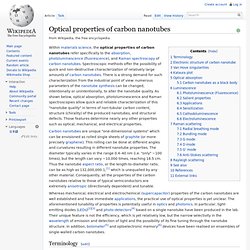
Spectroscopic methods offer the possibility of quick and non-destructive characterization of relatively large amounts of carbon nanotubes. There is a strong demand for such characterization from the industrial point of view: numerous parameters of the nanotube synthesis can be changed, intentionally or unintentionally, to alter the nanotube quality. As shown below, optical absorption, photoluminescence and Raman spectroscopies allow quick and reliable characterization of this "nanotube quality" in terms of non-tubular carbon content, structure (chirality) of the produced nanotubes, and structural defects.
Nanoscribe Will Sell a Micro 3-D Printer That Creates Tiny Structures in Seconds. Nanoscribe, a spin-off from the Karlsruhe Institute of Technology in Germany, has developed a tabletop 3-D microprinter that can create complicated microstructures 100 times faster than is possible today.
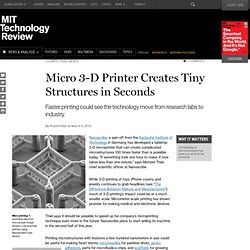
“If something took one hour to make, it now takes less than one minute,” says Michael Thiel, chief scientific officer at Nanoscribe. While 3-D printing of toys, iPhone covers, and jewelry continues to grab headlines (see “The Difference Between Makers and Manufacturers”), much of 3-D printing’s impact could be at a much smaller scale. Micrometer-scale printing has shown promise for making medical and electronic devices.
Thiel says it should be possible to speed up his company’s microprinting technique even more in the future. Nanoscribe plans to start selling its machine in the second half of this year. Electric motor made from a single molecule. 5 September 2011Last updated at 08:56 By Jason Palmer Science and technology reporter, BBC News The butyl methyl sulphide molecule whips round an axis defined by its single sulphur atom (blue) Researchers have created the smallest electric motor ever devised.

The motor, made from a single molecule just a billionth of a metre across, is reported in Nature Nanotechnology. World's smallest, fastest nanomotor can fit inside a single cell. Researchers at the Cockrell School of Engineering at The University of Texas at Austin have built the smallest, fastest and longest-running tiny synthetic motor to date.
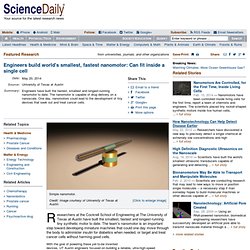
The team's nanomotor is an important step toward developing miniature machines that could one day move through the body to administer insulin for diabetics when needed, or target and treat cancer cells without harming good cells. With the goal of powering these yet-to-be invented devices, UT Austin engineers focused on building a reliable, ultra-high-speed nanomotor that can convert electrical energy into mechanical motion on a scale 500 times smaller than a grain of salt. Mechanical engineering assistant professor Donglei "Emma" Fan led a team of researchers in the successful design, assembly and testing of a high-performing nanomotor in a nonbiological setting. Nanomotors are controlled, for the first time, inside living cells. UNIVERSITY PARK, Pa. -- For the first time anywhere, a team of chemists and engineers at Penn State has placed tiny synthetic motors inside live human cells, propelled them with ultrasonic waves and steered them magnetically.
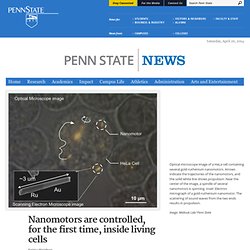
It's not exactly "Fantastic Voyage," but it's close. The nanomotors, which are rocket-shaped metal particles, move around inside the cells, spinning and battering against the cell membrane. "As these nanomotors move around and bump into structures inside the cells, the live cells show internal mechanical responses that no one has seen before," said Tom Mallouk, Evan Pugh Professor of Materials Chemistry and Physics. "This research is a vivid demonstration that it may be possible to use synthetic nanomotors to study cell biology in new ways.
Nanoelectronic circuits that operate more than 10. Medical ‘millirobots’ could replace invasive surgery. Cross-section: three-component Gauss gun before (top) and after (bottom) firing (credit: Aaron T.
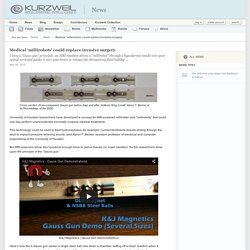
Becker et al. /Proceedings of the IEEE) University of Houston researchers have developed a concept for MRI-powered millimeter-size “millirobots” that could one day perform unprecedented minimally invasive medical treatments. This technology could be used to treat hydrocephalus, for example. Current treatments require drilling through the skull to implant pressure-relieving shunts, said Aaron T. Building Medical Robots, Bacteria sized: Bradley Nelson at TEDxZurich. Tiny Scallop-Like Robots Designed To Deliver Drugs Through The Bloodstream To Treat Diseases - Futurism. Synopsis Researchers in Germany have developed a "scallop-inspired" tiny robot small enough to travel through the bloodstream, and it doesn't require an engine or batteries Summary.
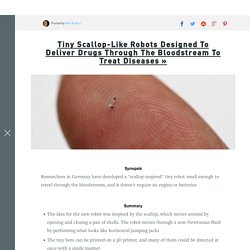
Lipid DNA origami may lead to advanced future nanomachines. Using a double layer of lipids facilitates assembly of DNA origami nanostructures, bringing us one step closer to future DNA nanomachines, as in this artist’s impression (credit: Kyoto University’s Institute for Integrated Cell-Material Sciences) Kyoto University scientists in Japan have developed a method for creating larger 2-D self-assembling DNA origami* nanostructures. Current DNA origami methods can create extremely small two- and three-dimensional shapes that could be used as construction material to build nanodevices, such as nanomotors, in the future for targeted drug delivery inside the body, for example.
KurzweilAI recently covered advanced methods developed by Brookhaven National Laboratory and Arizona State University’s Biodesign Institute. Researchers 3D-Print Microscopic Robots That Could Someday Revolutionize Medicine. Drones could be used to seek out arteries to prevent heart attacks. In Brief Researchers have completed the first successful tests of nanoparticles – which are targeted to go where they are needed – in mice, and hope to soon to conduct the first patient trials. The nanoparticles are designed to latch on to hard plaques in the arteries, made from fat cholesterol and calcium, which cause heart disease.
Each of the tiny particles, made from a plastic-like material, is 1,000 times smaller than the tip of a human hair.Once they reach their target, the “drones” release a drug derived from a natural protein that repairs inflammation damage in the body. ‘Microswimmer’ robots to drill through blocked arteries within four years. Drexel’s microswimmer robots (bottom) are modeled, in form and motion, after spiral-shaped Borrelia burgdorferi bacteria (top), which cause Lyme Disease (credit: Drexel University) Swarms of microscopic, magnetic, robotic beads could be used within five years by vascular surgeons to clear blocked arteries. These minimally invasive microrobots, which look and move like corkscrew-shaped bacteria, are being developed by an $18-million, 11-institution research initiative headed by the Korea Evaluation Institute of Industrial Technologies (KEIT).
Drexel engineers are able to control the movement of their micro-swimmer robots using magnetic fields (visual representation at right) generated by an electromagnetic device (left) (credit: Drexel University) Can DNA Nanobots Successfully Treat Cancer Patients? First Human Trial Soon. Can DNA Nanobots Successfully Treat Cancer Patients? First Human Trial Soon “No, no it’s not science fiction; it’s already happening,” said Ido Bachelet to a somewhat incredulous audience member at a London event late last year. Bachelet, previously of Harvard’s Wyss Institute and faculty member at Israel’s Bar-Ilan University, is a leading figure in the field of DNA nanotechnology. In a brief talk, Bachelet said DNA nanobots will soon be tried in a critically ill leukemia patient.
The patient, who has been given roughly six months to live, will receive an injection of DNA nanobots designed to interact with and destroy leukemia cells—while causing virtually zero collateral damage in healthy tissue. According to Bachelet, his team have successfully tested their method in cell cultures and animals and written two papers on the subject, one in Science and one in Nature. Activating a single gene reverses colon cancer growth in mice in just 4 days. DNA nanobots will soon be tried in a critically ill leukemia patient - Futurism. Synopsis The patient, will receive an injection of DNA nanobots designed to interact with and destroy leukemia cells-while causing virtually zero collateral damage in healthy tissue.
Summary According to expert Ido Bachelet, his team have successfully tested their method in cell cultures and animals and written two papers on the subject, one in Science and one in Nature.Contemporary cancer therapies involving invasive surgery and blasts of drugs can be as painful and damaging to the body as the disease itself. Nano-Robots That Compute With DNA Installed Into Living Cockroach. Scientists have inserted DNA-based nanobots into a living cockroach, which are able to perform logical operations. Researchers say the nanobots could eventually be able to carry out complex programs, to diagnose and treat disease.